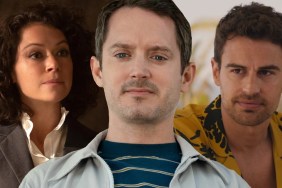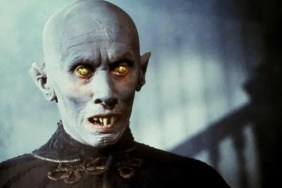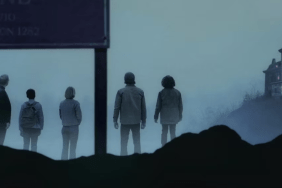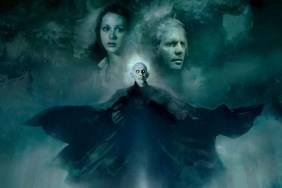Salem’s Lot: Writer Lee Gambin writes a personal piece examining Tobe Hooper’s 1979 adaptation of Stephen King’s Salem’s Lot
When I was a youngster, one of the very few “family rituals” that I would partake in was a Sunday afternoon trip to my grandparents’ house – it was most definitely a Maltese thing in the western suburbs of Melbourne, Australia, just ask anyone from that background who grew up in the seventies or eighties. Your immediate family would be there, as well as your aunts and uncles and numerous cousins, and this was generally fun and emotionally nourishing, but then of course adolescence would hit, and the furthest from your family you could be, the better! But, on one such visit in such halcyon days, my cousins and I found out from our beautiful grandmother Maria (an incredible storyteller in her own right) that a nearby house was newly abandoned and was dramatically vacated – she explained that the man who lived there was taken into an asylum for psychiatric care. Of course the collective ears of the “gang” and I pricked up, and we decided to trek it out there and sneak inside. The place was completely turned over; an absolute trash heap and we stumbled through the wreckage like ghouls exploring a crime scene. The others commented on the smell and the filth and were eager to leave, and I was with them, however something caught my eye amongst the mess. It was a much-loved paperback lying upon the floor and almost beckoning for me to grab hold of it. The novel was Salem’s Lot. It was the Signet edition with that incredibly striking embossed image of a little girl vampire (possibly Mary Kate Griegson who was kicked off the school bus by the mean-spirited Charlie Rhodes) staring right at you with dead eyes and a tiny droplet of blood hanging off the left side of her mouth. I picked it up, stuffed it into my jacket pocket and that night, my love affair with a small New England town succumbing to an infestation of vampires began. However, I was already obsessed with Salem’s Lot before finding Stephen King’s novel in this abandoned house – and the reason being because I saw the TV miniseries long before diving into the book.
I don’t know how old I was when I first saw Tobe Hooper’s adaptation air on television – I guess an Australian TV historian aka “a living TV Guide” would be able to work out when it aired in Melbourne in the early ’80s as a first round re-run – but the vivid stabs of memory from that first ever viewing still pulsate and make their presence known every time I revisit Hooper’s superlative piece of filmic work. And yes, I do consider it “filmic”. Of course it was made for the CBS network and presented over two nights (because of its massive scope), but you also have to remember that it was produced by Warner Bros. and it most certainly unfolds and reads as a cinematic feature. This sweeping saga of a small town slowly coming to know great darkness is expertly crafted by the late great Tobe Hooper and his handle on character, theme, multiple plots and narrative structure is outstanding. His work is also remarkably terrifying and has the power to get under your skin even throughout seemingly benign sequences and the magnificent marriage of the vampire mythology with multiple classic and much loved horror trappings such as the haunted house motif, the Ten Little Indians trope and childhood trauma is puppeteered with sturdy finesse.
Grace Metalious’s Peyton Place was a primary source of influence for Stephen King in his writing of Salem’s Lot. In Metalious’s novel, the “evil” would come from deep rooted secrecy in a small New England town and the creeping awareness of sexual knowledge that “threatens” the conservative/repressed, whereas in King’s book, it would be vampirism that would take down an entire community one by one. The concept for King’s novel was the idea that a small town, much like Metalious’s provincial hamlet, would be visited by Dracula (Bram Stoker’s Gothic classic being the second essential muse). In the film adaptation of Peyton Place, the line “You turn off the lights and see what develops” comes about when a young teenager is caught out with a bunch of friends playing a forbidden game of “making out” and “heavy petting” in complete blackout. When he is busted by the sexually oppressed Lana Turner, he explains that this “party game” is akin to photography – where you would develop your image in the dark. This is precisely what Tobe Hooper does with his superlative interpretation of Stephen King’s east coast vampires. These ghostly and ghastly monstrous entities are genuinely conceived in the darkest recesses of artistic intention and they are born from primal fears that are only ever realized when consumed by enveloping gloom. There is nothing soft or romantic about them; instead, they are feral and devoid of any glamour – violently devoted to parasitic purpose and generating an age old dedication to spreading a plague.
When I first saw that image of Kurt Barlow’s (Reggie Nalder) face flash at the local lockup where young Ned Tebbets (Barney McFadden) was kept after beating up the film’s protagonist Ben Mears (David Soul), I was hooked on the design of these vampires. Barlow became an instant obsession for me – with his blue skin, glowing yellow and red eyes, dome head, rodent-like sharp fangs, bat shaped ears and elongated bony fingers which were much more like claws, he was an essential movie monster absolutely made for idol worship. I would spend endless days drawing him over and over again, in varied positions and with other townsfolk in their vampire state standing by his side, completely under his rule and dedicated to his cause. The power of Reggie Nalder’s Barlow under the direction of the exceptionally gifted Tobe Hooper was the fact that just by looking at this nocturnal nightmare you understood the profound ancient evil that he advocated. This was all in the visceral onslaught of such an operatic goliath who absolutely terrified me during the scene where he emerges from a telekinetic tremor, appearing as a mass of black cloak on the Petrie kitchen floor. So much like Margaret Hamilton’s Wicked Witch in The Wizard of Oz (another movie monster that generated so much gleeful joy in this head of mine), Barlow’s entrance is sudden and startling, rising from the depths of hell and instantly destroying what is supposedly wholesome and ideal by smashing the heads of Ted and June Petrie (Joshua Bryant and Barbara Babcock) together, killing them, and hence killing the safety net of domesticity. Along with his “keeper”; the urbane, sophisticated antiques dealer Richard K. Straker (James Mason), Barlow threatens the sanctity of American values by introducing something older than Christian ideology, a western morality value system and small town sensibility. What he presents is something purely bestial and also utterly parasitic, and a creeping terror that survives in the deep stillness of darkness.
Tobe Hooper’s treatment of Marjorie Glick’s (Clarissa Kaye) waking at the morgue is just as sensational. The sheer tension as Ben Mears sits and waits for her to “rise from the dead” is chilling. Intercutting Ben trembling as he weaves together a make-shift cross with medical popsicle sticks with the hanging clock ticking away counting down the time and finally that eerie image of Marjorie’s undead body lying under a crisp white sheet, Hooper concocts a compelling sequence that is meticulously constructed and has a payoff that is nightmare inducing. When Marjorie wakes, the sheet slides off her with quiet ease, and her body props up like a marionette coming to life. Calling out for her lost son (lost to vampirism much earlier) this creature of the night quickly goes from spine-tingling serenity to fang-bearing ferocity in a frenzied showdown between Ben and Dr. Bill Norton (Ed Flanders).
Susan Norton (Bonnie Bedelia), the resident art teacher who had left Salem’s Lot, but since returned, is a character I feel Tobe Hooper truly understood very well. Bedelia took the material incredibly seriously and read into vampire lore and literature while shooting the miniseries and Hooper seems to respond to this fact by feeding her many scenes (mostly shared with David Soul) with inspired direction. The first meeting of Susan and Ben in the parklands is a loaded scene with multiple character development injected in there and follow up scenes where the duo have romantic interludes near the lake are painted with quiet romance that elegantly suggest the “calm before the storm”. When Susan explores the Marsten house near the end of the miniseries, Hooper really has fun directing a straight up horror fantasy having his heroine race through the grimy, gothic manor, racing through the corridors and the like in a state of panic and dread. When she finally succumbs to vampirism, the sequence reads like a glorious Hammer horror film of the sixties or seventies, where a lustful bloodsucker attempts to entice her intended hoping he is not such a “righteous man”. I remember when I first rented the VHS of Salem’s Lot and it was of course the theatrical cut, the fate of Susan was not included. This drove me crazy! Although the theatrical cut had a more violent edge and there was that even more intense sequence with Cully (George Dzunda), Bonnie Sawyer (Julie Cobb) and Larry Crockett (Fred Willard) where the latter two’s affair had been discovered and a gunpoint was a truly harrowing ordeal to watch, the theatrical cut sadly left out some pivotal moments that not only propelled the story but also showcased some of Tobe Hooper’s exceptional work as a director. For instance, his work with actress Marie Windsor who played boarding house owner Eva Miller, where she falls under the early influence of vampirism and recounts a dream she had to a nervous Susan. Hooper directs Windsor in a straight forward fashion, giving this esteemed and well-seasoned actress room to take the monologue wherever she wanted. It is also an inspired choice that Hooper cast her and Elisha Cook Jr. as “Weasel” Phillips (her estranged husband, now the town drunk) seeing that the pair had appeared as a shady married couple in Stanely Kubrick’s 1956 noir classic The Killing (a favorite of Hooper’s) proving that once again – much like his peers, Brian De Palma, John Carpenter, Joe Dante, John Landis et al – Hooper was a film maker who was also a dedicated cinephile, and lover of all kinds of films.
I’ve often talked about two major elements of Salem’s Lot that were heavily inspirational for me and they were the fact that this was the first time I saw working class vampires and child bloodsuckers. In regards to the former, Tobe Hooper delivers a traditionally aristocratic movie monster in blue collar terms with blue collar sensibilities. Instead of counts, countesses, princes and royals from antique European regions, we get truck drivers, school teachers, waitresses, grave diggers and homemakers as the fanged, treacherous undead. While the Glick brothers tapping at the window hissing “let me in” was the first time I saw pintsized vampires in film – this was way before I watched Homer (Joshua John Miller) boss his fellow nomad immortals around in NEAR DARK and way before 1994 hit where young Kirsten Dunst stole the show as the doll-like Claudia in Interview With the Vampire. Of course I recall the baby vampire from Grave of the Vampire from a late night viewing on TV in my early teens, and that made me instantly think of Sandy McDougal’s infant Randy from the novel of SALEM’S LOT who fed on blood (something omitted from Paul Monash’s teleplay – as many things had to “give” and had to be altered) but in general, the Glick brothers (Danny (Brad Savage) and Ralphie (Ronnie Scribner)) were the staple vampiric youngsters for me. The image of Danny Glick floating outside Mark Petrie’s (Lance Kerwin) large bay window engulfed by a ghostly fog haunted my nightmares for many years, and was a massive comfort for me. It was such a visual treat for me – something that I treasure and will forever. There is a massive warmth and heartfelt great love for this moment as it truly celebrates the “monster kid” sentiment – and it is an extension to an earlier scene where Mark (a true “monster kid” himself) explains what a ghoul is to the Glick brothers (not “monster kids” but soon transformed into creatures of the night that Mark “knows all too well”). I also responded to Tobe Hooper’s tribute to Disney’s Peter Pan here where he has his floating child vampire promise eternal life and perpetual childhood, something that J.M. Barrie’s literary pixie embodies.
One of the most powerful moments in the miniseries is the newfound vampirism of grave digger Mike Ryerson (Geoffrey Lewis). This is one of those blood curdling sequences that sends chills down your spine and burns itself into your horror movie memory bank forever. The moment Mike is born into darkness is scary enough (seduced by something from young Danny Glick’s grave and coming face to face with the pale faced juvenile vampire baring his sharp fangs) and even the follow up scene where he turns up at a restaurant only to interrupt a conversation between prodigal son Ben Mears and his former English teacher Jason Burke (Lew Ayres), drowsy and lost in confusion. Then finally, the payoff is an outstanding achievement in filmic “spookshow” where a nervous Jason Burke ascends his flight of stairs to find Mike in a rocking chair seemingly fogged by catatonia. When Mike lifts his head and stares directly into Jason’s eyes ordering him to “Look at me”, it is pure monster movie magic. The demonic hissing from Geoffrey Lewis’s Mike is mesmerising and hypnotic and most importantly infinitely scary. Tobe Hooper truly elicits a horrific image of bestial and malevolent seduction. “You’ll sleep like the dead” hisses Mike, as the quivering Jason wields a crucifix before him, revoking his invitation and sending him out of his homestead and into the night to group with his fellow undead. This sequence in the novel also terrified me as a child (possibly the only ever time I actually had the hairs on the back of my neck stand up and jolt and turnaround from reading such chilling scripture). This scene plus the aforementioned appearance of Barlow in the Petrie kitchen, the Glicks at the window and more would become re-enacted by my cousins and I after multiple viewings of the theatrical cut on the CBS VHS which was continually rented from George’s Video Shop or MovieLand in St. Albans and collectively watched at my grandparents. It became a tradition. And I will treasure that forever. So thank you Mr. Tobe Hooper – for giving Stephen King’s blue collar, working class New England vampires a distinctly feral tone, a snarl that was purely terrifying and a menace that was penetrative and lasting. Hooper was a superb talent and Salem’s Lot is an absolute testament to his masterful handling of this sweeping story of a small town consumed by ancient evil and understanding the power of darkness.










